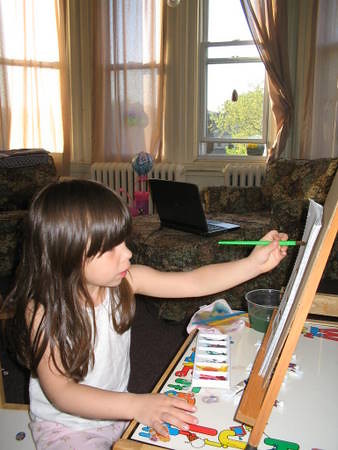Painters (Artists)
Artists Painting – Posture and Symmetry in the Alexander Technique (Pain, Strain, Injuries, Psychology)(Albuquerque)
This ebook, An Alexander Technique Approach to Artists’ Painting Technique, is published on this website in a PDF format. It is very detailed and practical. It will give you the physical tools you need to take the limits off of your ability to create the painting technique you want without sacrificing your body.
This ebook is also for sale on all AMAZON websites in a KINDLE format.
Located in Albuquerque, New Mexico, U.S.A. (MOVEMENT THERAPY)
SYMMETRY IS NOT THE GOAL WHEN YOU WORK WITH AN ALEXANDER TECHNIQUE TEACHER, BUT YOU USUALLY CREATE A MORE SYMMETRICAL BODY. Let me explain.
When you attempt to solve postural and pain problems by looking in a mirror and making your body’s alignment more symmetrical, you usually lock your whole body into a static posture. The result of this going for static symmetry is more pain in your body. Why?
When you attempt to solve postural and pain problems by finding a static position to be in, you’re immobilizing your body, hoping that if you just place the different parts of your body in the right relationship to each other, you’ll stop hurting.
IT DOESN’T WORK! BECAUSE THERE IS NO SUCH THING AS THE BEST POSTURE OR BEST ALIGNMENT OR A STATIC BODY!
When you introduce movement and flow into your body, then you begin to realize that you can do everything you do without immobilizing your musculature.
What is so tough about this way of relieving physical pain is it is hard to capture what it is you are doing. When you begin to view your body in terms of how it moves, rather than where the various parts of it should be, you have to be ready to experience yourself as a body always in flow and never held rigidly still.
This goes against almost every single movement modality that is offered to solve movement and pain and injury problems out there.
IS IT POSSIBLE TO CAPTURE, TO PRACTICALLY APPLY LEARNING TO YOUR BODY WITHOUT LOCKING IT DOWN, TO DO WHAT YOU WANT TO DO PAINLESSLY? YES! HOW?
It requires a real shift in how you control/talk to your body.
INSTEAD OF ASKING THE PARTS OF YOUR BODY TO BE IN SPECIFIC STATIC POSITIONS, YOU ASK THE PARTS OF YOUR TO RELEASE THEIR HOLDING AND WORK TOGETHER. This means focusing, without tension, on how you’re doing what you’re doing, not on what you’re doing.
Example: When you look at walking as an example and attempt to analyze what good walking is traditionally, you focus on placing your arms and legs in certain positions. BUT WALKING IS CONSTANT MOVEMENT!
What if you placed your awareness on free swinging arms, on a neck unlocked, on knees preceding your feet, and let the walking take care of itself, as you free your body from head to toe? What would result?
Maybe for the first time in your life you’d connect to your body in motion, rather than forcing your body to move as you simultaneously stop it from moving.
What I’ve just written is incredibly practical. It is what I did to learn to practice for hours and hours on the guitar, finally without pain and strain and exhaustion.
What I’ve just written can be applied to everything you do, if you’re willing to accept you can have conscious control over your musculature. You do this by slowing down your specific activity to take care of yourself.
FOCUS ON HOW YOU DO WHAT YOU DO, NOT ON GETTING IT DONE PAYING A PHYSICAL PRICE!
